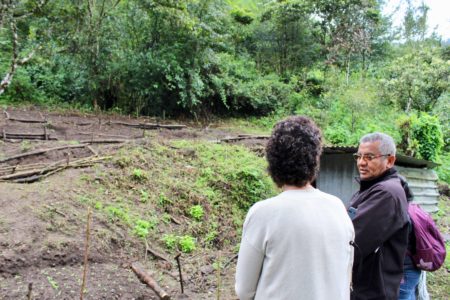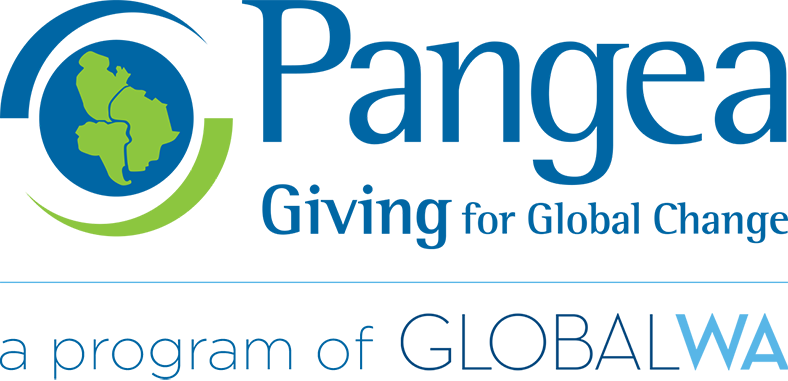Pangea defines a different way of travel
The Oaxaca Site Visit team converged at the lush garden filled Hotel Las Golondrinas on a Sunday night in time for a first sampling of the enticing local cuisine and a planning session for the week ahead. The group, consisting of two men and two women from four different decades, came together after spending the previous days visiting a variety of locations: water projects in Ecuador, the sights of Mexico City, and an exemplary Rotary Project supporting hydroponic green houses in rural Oaxaca.
How often can we travel with a small group diverse in age and gender, where we together do a deep dive into the cultural and political realities of a specific region?

Beside the significance of developing team camaraderie, a second important dimension of site visits is learning the context in which Pangea funds. In this case, we learned about the impact of an exploding tourism scene on Oaxaca, a city becoming unaffordable for many long-term residents. We saw the commercialization of traditional artisanry in an effort to respond to what tourists want to buy. We noted the effects of mega projects from foreign investors—mining, dams, wind turbines, and drilling for gas—where the people are coerced to comply, the profits leave the community, and the land is rendered unusable. We heard stories about a new colonialism with the influx of Evangelical and Pentecostal missionaries who convert indigenous villagers with promises, divide communities, and threaten the interdependence and governing structure in small villages that has existed for centuries. And we learned about how climate change affects agriculture with the rains—once predictable—coming now just before the harvest and rotting the crops.
How often do we travel seeing what is behind a place and its people? Visiting the city of Oaxaca as so many do, it would be very easy to not look beyond the quaint, colorful streets, and favorable places for American tourists.
Our three grant partner organizations address issues critical to local women’s rights like supporting victims of gender-based violence and educating on healthy relationships and family planning. UNOSJO (Union de Organisacion de la Sierra Juarez, Oaxaca) uses an integrated approach in working with 13 remote indigenous Zapotec communities. They define violence broadly—violence against women due to increased migration, economic violence brought on by climate change, violence to the soil with genetically modified seeds. UNOSJO staff travel regularly to the communities, to train teachers and give workshops for students that open their minds and raise their consciousness about new ways of thinking. We traveled three hours on curvy, unpaved roads, in a torrential rainstorm to visit one of UNOSJO’s schools in San Juan Yagila. Here we saw small vegetable gardens used to teach students to connect with the earth and to use traditional agricultural techniques that conserve the richness of the land.
Our grant partner MUSOR works in the densely populated and marginal community of Xoxocotlan outside the city of Oaxaca. A large percentage of the population are migrants from villages around the state who have left their families behind to try to make a living near the regional capital. MUSOR staff member Dr. Francisca conducts workshops in several middle schools where she boldly trains youth on their sexual and reproductive rights, topics the students confirmed they do not discuss at home. Students demonstrated their newfound knowledge by composing songs, spoken word, skits, and “acrosticas” (posters where they further define and elaborate on each right). In one school the students put on a parade of contraceptives, including a condom costume made from cardboard, an IUD from metal rods, a patch from cloth.



Our third and long-term grant partner GES MUJER has gained significant credibility in the region on topics concerning women. They host talks on sexual and reproductive rights, advocate for the legalization of abortion, offer legal assistance and counseling for victims of sexual violence, and provide a venue for visiting artists doing theater of the oppressed. Their signature program is an intensive six-month leadership seminar for young indigenous women who stay in the dormitory, form a lasting network of mutual support, and return to their villages taking leadership for a project. We met four of the 127 young women who have graduated from the seminar. Each was impressive in her strength of commitment to her community—offering training to girls on sexuality and reproductive rights, gender equity, and raising awareness about violence towards women that often begins during courtship. The young women leaders come from villages bound by their indigenous governing structure and systems called usos y costumbres. Although women have traditionally been barred from holding official positions of leadership, we learned that several had broken this barrier of gender and tradition to be elected into leadership positions.
Pangea is unique. How often do we share tlayudas, tamales, caldo de gallina, champurada and conversation in shacks with dirt floors, bounce along in a crowded van or in the back of a pick-up truck with people working in the trenches? We immersed ourselves for a week with staff and students from three organizations, observed how they address the alarming problem of violence towards women. We learned about community strength and the threats that impinge on progress. We listened, setting aside our own lens for what is needed, and we asked to learn more.
This post was written by Pangea member Betsy Hale.

